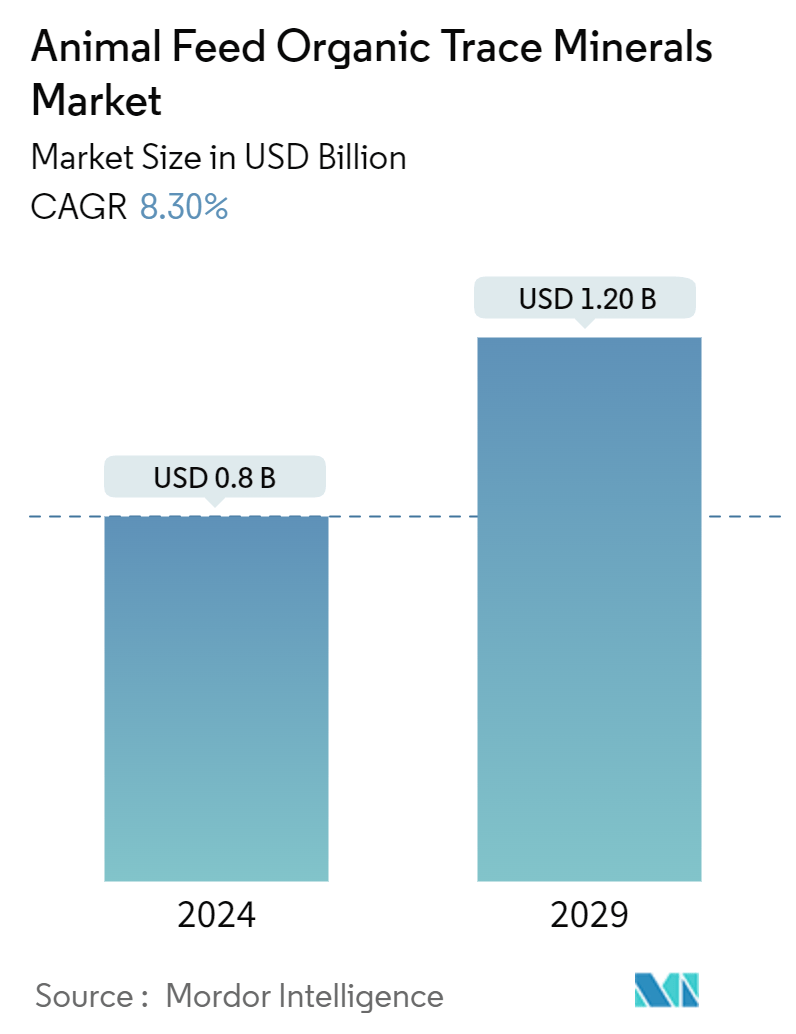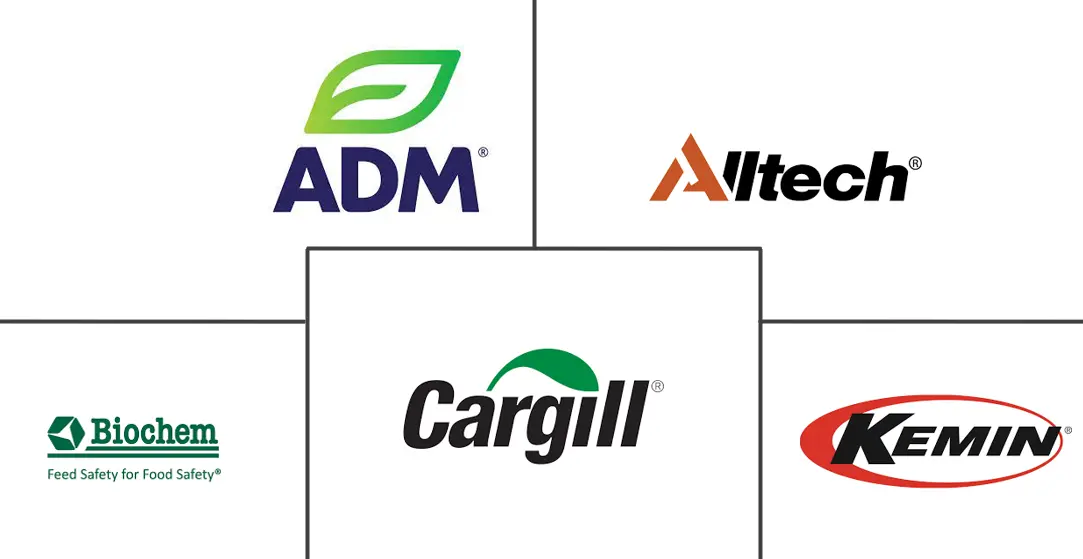Market Size of Animal Feed Organic Trace Minerals Industry

| Study Period | 2019 - 2029 |
| Market Size (2024) | USD 0.8 Billion |
| Market Size (2029) | USD 1.20 Billion |
| CAGR (2024 - 2029) | 8.30 % |
| Fastest Growing Market | North America |
| Largest Market | Asia Pacific |
| Market Concentration | Low |
Major Players
*Disclaimer: Major Players sorted in no particular order |
Animal Feed Organic Trace Minerals Market Analysis
The Animal Feed Organic Trace Minerals Market size is estimated at USD 0.8 billion in 2024, and is expected to reach USD 1.20 billion by 2029, at a CAGR of 8.30% during the forecast period (2024-2029).
- Organic trace minerals are pivotal to the global livestock industry, enhancing animal health, productivity, and overall performance. As global demand for meat, dairy, and poultry surges, the livestock sector intensifies its focus on bolstering animal health and performance. These organic minerals boost feed efficiency, weight gain, fertility, and immune function, culminating in superior animal products.
- Unlike inorganic minerals, organic trace minerals are deemed more eco-friendly. They minimize mineral waste excretion, thereby curbing environmental pollution. This eco-conscious shift in livestock practices fuels the demand for organic trace minerals. Furthermore, livestock farmers are increasingly becoming cognizant of the advantages of organic minerals in feed, including enhanced disease resistance, robust bone development, and optimal reproductive health. This growing awareness propels the demand for premium feed supplements, prominently featuring organic trace minerals.
- The rising trend of precision nutrition, tailoring diets to the specific needs of each species or production stage, forecasts a surge in the adoption of organic trace minerals, recognized for their efficiency in meeting these precise nutritional demands. Moreover, as nations pivot to curtail or abolish antibiotics in animal feed, organic trace minerals are emerging as the favored alternative for ensuring animal health and growth.
- With the global livestock industry leaning towards sustainable, health-centric, and efficient feeding practices, the market for organic trace minerals is on an upward trajectory. This demand is fueled by aspirations for enhanced animal health, boosted productivity, and a global shift towards eco-friendly and antibiotic-free farming. As awareness broadens and feed formulation innovations continue, the organic trace minerals market is primed for significant expansion, especially in regions witnessing a surge in meat consumption and the adoption of advanced farming techniques.
Animal Feed Organic Trace Minerals Industry Segmentation
Organic trace minerals in animal feed are essential minerals attached to organic molecules, like amino acids or peptides, enhancing their absorption and bioavailability in livestock. Key minerals such as zinc, copper, iron, manganese, and selenium play crucial roles in animal physiology, supporting functions like growth, reproduction, immune response, and overall health. The Animal Feed Organic Trace Minerals Market is segmented by Trace Element Type (Zinc, Iron, Copper, Manganese, Selenium, and Others), Animal Type (Dairy Cattle, Beef, Poultry, Swine, Aquaculture, Pets, and Others), and Geography (North America, Europe, Aisa-Pacific, South America, and Africa). The report offers market estimation and forecasts in value USD for the above-mentioned segments.
| Trace Element Type | |
| Zinc | |
| Iron | |
| Copper | |
| Manganese | |
| Selenium | |
| Others |
| Animal Type | |
| Dairy Cattle | |
| Beef | |
| Poultry | |
| Swine | |
| Aquaculture | |
| Pets | |
| Others |
| Geography | |||||||
| |||||||
| |||||||
| |||||||
| |||||||
|
Animal Feed Organic Trace Minerals Market Size Summary
The animal feed organic trace minerals market is experiencing significant growth, driven by increasing awareness of the adverse effects of inorganic trace minerals containing heavy metal contaminants. This shift is prompting a rising demand for organic alternatives, despite their higher cost. Organic trace minerals are crucial nutrients used in small quantities in animal feed, and their popularity is further bolstered by the growing consumption of water-soluble natural feed additives and the expanding animal feed industries worldwide. The global trend towards higher protein consumption from animal sources is also contributing to the market's expansion, as meat consumption continues to rise, particularly in the Asia-Pacific and South American regions. These regions are witnessing changes in dietary patterns, urbanization, and economic growth, which are fueling the demand for organic trace minerals in animal feed.
The Asia-Pacific region holds a significant share of the market, with China leading the demand for organic trace minerals due to its burgeoning meat industry and the presence of key manufacturers. The region's rapid economic growth has spurred an increased demand for meat protein, prompting higher meat production and a greater uptake of feed with organic trace elements. This trend is supported by the global increase in population, life expectancy, and the need for sustainable animal feed production methods. The market is characterized by fragmentation, with numerous small and medium-sized companies, alongside major players like Alltech, Archer Daniels Midland Company, and Cargill, actively expanding their presence through strategic mergers and acquisitions. These companies are investing in innovation and technology to maintain their competitive edge and cater to the growing global demand for organic trace minerals in animal feed.
Animal Feed Organic Trace Minerals Market Size - Table of Contents
-
1. MARKET DYNAMICS
-
1.1 Market Overview
-
1.2 Market Drivers
-
1.2.1 Increasing Demand For Meat and Animal Protein
-
1.2.2 Reduction in Antibiotic Use
-
1.2.3 Increasing Government Initiatives
-
-
1.3 Market Restraints
-
1.3.1 High Costs of Organic Trace minerals
-
1.3.2 Limited Awareness and Adoption
-
-
1.4 Porter's Five Forces Analysis
-
1.4.1 Bargaining Powers of Buyers
-
1.4.2 Bargaining Powers of Suppliers
-
1.4.3 Threat of New Entrants
-
1.4.4 Threat from Substitute Products and Services
-
1.4.5 Competitive Rivalry
-
-
-
2. MARKET SEGMENTATION
-
2.1 Trace Element Type
-
2.1.1 Zinc
-
2.1.2 Iron
-
2.1.3 Copper
-
2.1.4 Manganese
-
2.1.5 Selenium
-
2.1.6 Others
-
-
2.2 Animal Type
-
2.2.1 Dairy Cattle
-
2.2.2 Beef
-
2.2.3 Poultry
-
2.2.4 Swine
-
2.2.5 Aquaculture
-
2.2.6 Pets
-
2.2.7 Others
-
-
2.3 Geography
-
2.3.1 North America
-
2.3.1.1 United States
-
2.3.1.2 Canada
-
2.3.1.3 Mexico
-
2.3.1.4 Rest Of North America
-
-
2.3.2 Europe
-
2.3.2.1 United Kingdom
-
2.3.2.2 France
-
2.3.2.3 Italy
-
2.3.2.4 Germany
-
2.3.2.5 Rest of Europe
-
-
2.3.3 Asia-Pacific
-
2.3.3.1 China
-
2.3.3.2 India
-
2.3.3.3 Japan
-
2.3.3.4 Australia
-
2.3.3.5 Rest of Asia-Pacific
-
-
2.3.4 South America
-
2.3.4.1 Brazil
-
2.3.4.2 Argentina
-
2.3.4.3 Rest of South America
-
-
2.3.5 Africa
-
2.3.5.1 South Africa
-
2.3.5.2 Rest of Africa
-
-
-
Animal Feed Organic Trace Minerals Market Size FAQs
How big is the Animal Feed Organic Trace Minerals Market?
The Animal Feed Organic Trace Minerals Market size is expected to reach USD 0.8 billion in 2024 and grow at a CAGR of 8.30% to reach USD 1.20 billion by 2029.
What is the current Animal Feed Organic Trace Minerals Market size?
In 2024, the Animal Feed Organic Trace Minerals Market size is expected to reach USD 0.8 billion.

